Jonathan Hooper, is a painter who depicts the residential architecture of suburban Leeds, specifically the north-west areas including Headingley, Hyde Park, Burley, Kirkstall and Meanwood. His work captures everyday scenes, highlighting the beauty and individuality of built landscapes in his immediate surroundings. He uses limited colour palettes for each series, that are chosen to create an emotional atmosphere that mirrors the character of the subject rather than imitating its visual appearance.
Court Spencer visited him in his home studio to find out more about his work.
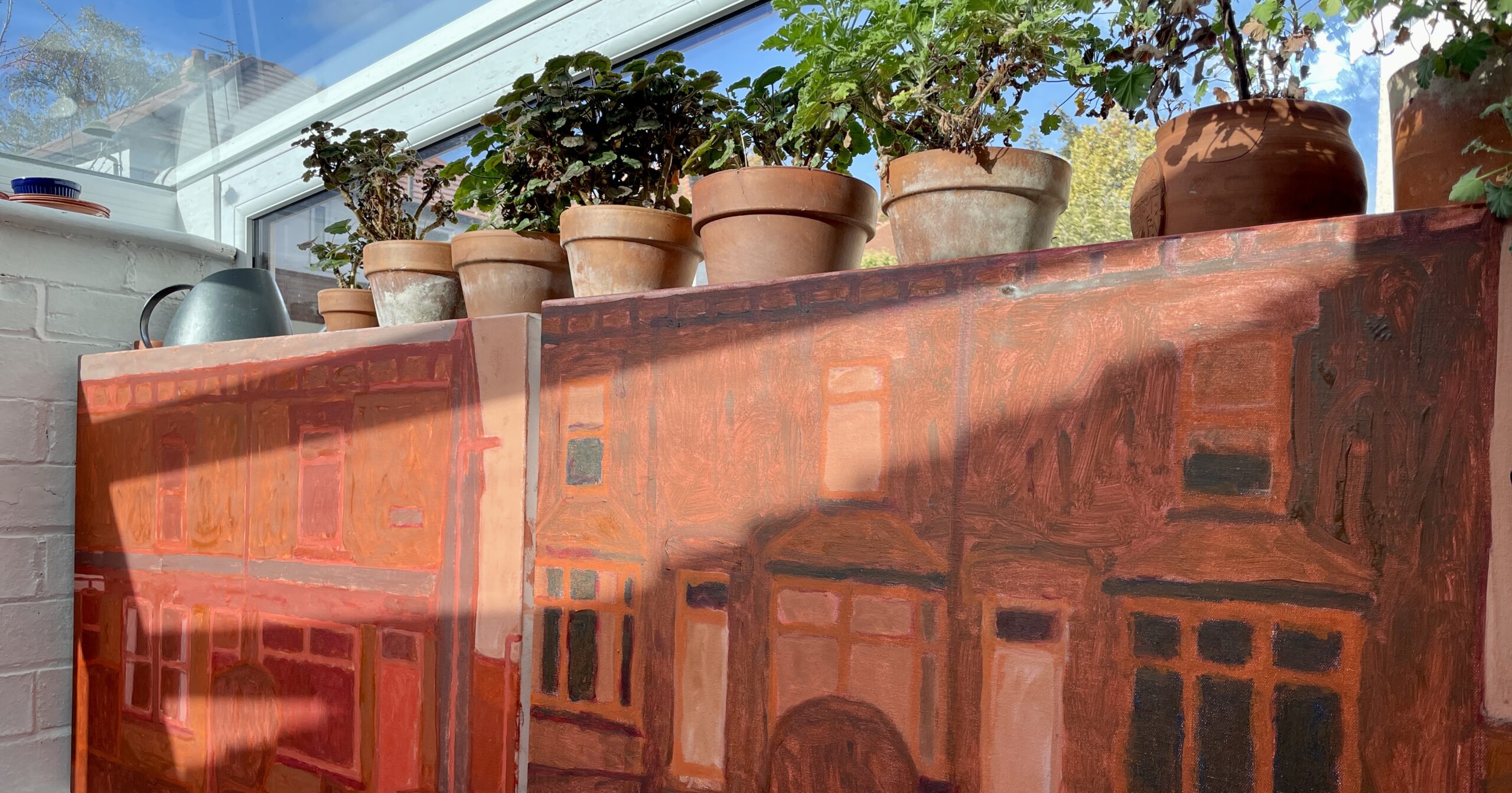
Work in progress under the pot plants in the studio.
Court: Hey Jonathan! Thank you so much for having me over. When I lived on the next street over and I always noticed this house as it’s got a lovely cottage feel that’s slightly different to the others. It feels very fitting that the artist who paints houses, lives in a house that I noticed on my daily dog walks! So what is it about houses that appeals to you and makes them the subject of your work?
Jonathan: Thank you Court, that’s nice to hear! I think with houses it’s a combination of things. I’ve always loved landscape painting – this is my local landscape, and so it feels natural to paint it. I made a conscious decision thirteen years ago to make a very direct sort of painting and to take my subject matter exclusively from the world immediately around me. There is something I find compelling specifically about houses as opposed to other sorts of buildings, their connection to the human. Not just the emotional attachment to a “home”, but also their scale, formal arrangement, and the way their external forms and internal spaces are imprinted in our minds.
Court: How long have you been painting for? Can you tell us a bit about university and the art you made back then and how you’ve arrived at suburban houses?
Jonathan: A long time – my grandfather was a talented amateur painter, and he taught me oil and watercolour painting as a boy. Although I loved art, I ended up going down an academic route at school and went to study biochemistry at university. I left after just a year and started painting seriously, going to evening classes, I did my Foundation at my local college in High Wycombe, Bucks before doing a degree at Falmouth in Cornwall.
On Foundation and the first year of my degree I made expressive landscapes. In my second and third years at Falmouth I specialised in printmaking and made work incorporating photographs and text, with political subjects. Leaving college was quite a jolt – losing the technical facilities and the camaraderie – and I found it difficult to carry on my work in the same way. My work gradually changed – I worked smaller, taking inspiration from poetry and subject matter from my immediate surroundings, and looking for a more atmospheric imagery. I made some small books of photographs looking out of the windows in my house, and previous houses I’d lived in in Leeds: those books led via a rather circuitous route to what I do now.
Court: That’s really nice, I love hearing about what has influenced an artist and got them to this point in their practice. Are there any specific artists or periods of art history that inspire your work?
Jonathan: I am particularly inspired by British painting. I love the 18th and early 19th century landscape tradition including Cotman, Girtin, Constable, with their patient observation of real places and loose atmospheric style. My decision to make direct work based on the world around me was influenced by Ruskin and the Pre-Raphaelites.
I particularly love Sickert, possibly my favourite painter. His unconventional cropping and viewpoints, how he carries the new aesthetic of photography into painting, his use of close and simple colour relationships, and his approach to painting buildings, interiors and exteriors. His fellow Camden Town painters are also an inspiration, Ginner and Gilman who both painted the city of Leeds, and Spencer Gore who painted houses in the new outer suburbs of London.
There is a lot of other 20th century British painting I love: Ben Nicholson’s sensitive command of abstract shape and line, Bomberg’s colourful and physical landscapes, the Euston Road Group’s documentary paintings of changing cities, and Peter Doig’s unsettling images and novel application of paint.
Court: How do you choose what you’ll paint? Have you included your house or previous homes in paintings?
Jonathan: I find subjects while walking, and I take a lot of photos. Sometimes I continue from a series I’ve just finished, looking for a different sort of house in the same neighbourhood, or for similar houses in a different neighbourhood. Sometimes I explore a new area with an open mind. At home I go through the photos, spending a lot of time looking at them, cropping them, thinking about them, before I start drawing from them. At this stage I often see things I wasn’t aware of while taking the photos, and I keep revisiting the places to look again, and take more photos.
My current and previous homes do appear in a few of my paintings, but this isn’t really important to me. Personal connection is one of place and atmosphere rather than a single specific building.
Court: Yeah that makes sense, and in the UK many of the houses in an area are built to the same design, so you can see a place and connect it to a friend who lives in a similar house. Do you ever get really attached to a piece and decide not to sell it?
Jonathan: No, I am very happy if someone else likes a work enough to want to buy it. I do like my own work, and I have recent work up in my house while I think about what has and hasn’t worked but what really interests me always is what I am working on at the moment.
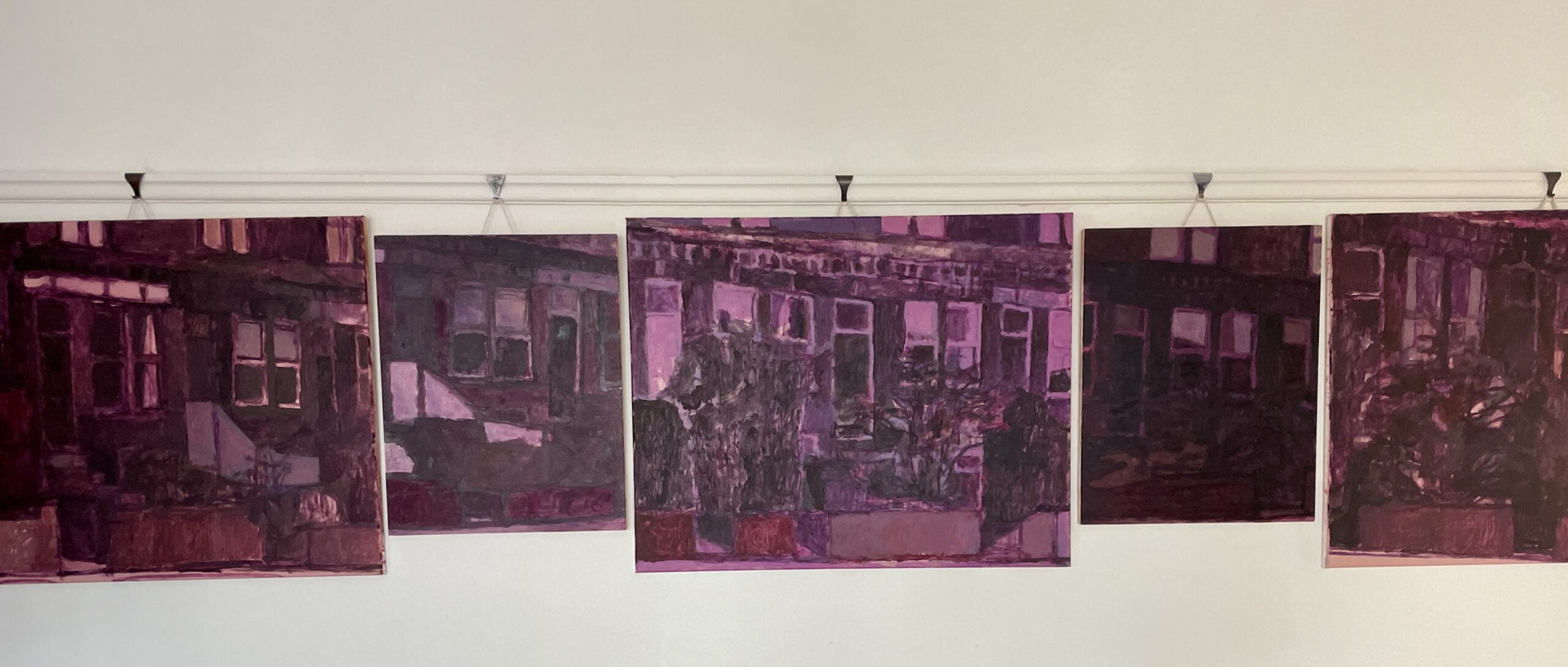
A series of works hung up to contemplate.
Court: You have a distinctive muted pallet, even the vibrant citrus tones have a dusty quality to them, and in some series the tonal range is quite minimal. Can you tell us about your pallet and how you choose what is right for a specific scene or building?
Jonathan: Colour has always been very important to me, and the painters I love are all colourists. I think my use of restricted colours goes back to studying printmaking at college. In print, you typically work with a very small number of colours in one image, the particular colours you choose and their relationships become crucial to the work.
The main function of colour in painting for me is to create atmosphere and emotion: I don’t want to copy the colours in the physical subject, but to create an atmosphere in a painting that mirrors the atmosphere of the subject. I print the photos I work from in black-and-white to avoid distraction, and I take colour from my memory of the subject, my imagination, and through improvising with watercolour. Typically for a series the colour will evolve organically to something that feels right to me at that time for that subject.
Court: How often do you get into the studio? Do you have a set routine and approach to your work?
Jonathan: I do some painting or drawing pretty much every day, except when I’m away on holiday, as I can’t work when I’m away from home. I don’t have a rigid timetable but typically I will go for a walk first thing, either to look at and photograph the subject I’m working on, or to look for new subjects. Then there is a lot of admin, answering emails, applying for exhibitions, photographing work, packaging and posting sold work, managing social media and website. I might do some drawing before lunch, and more drawing and painting in the afternoon.
Court: That sound like a really nice balance. What do you see as some of the pros and cons of having a home studio?
Jonathan: The big advantage is the flexibility it gives with family life, it’s possible to do ten minutes of painting before leaving for work, or while the tea is cooking, or late in the evening. Also, my own work has a domestic scale and subject, and I like being able to see it in my own home as I work on it. I suppose the big disadvantage is that I have less space to work and to store work than I would in a typical studio, which constrains the size of my work.
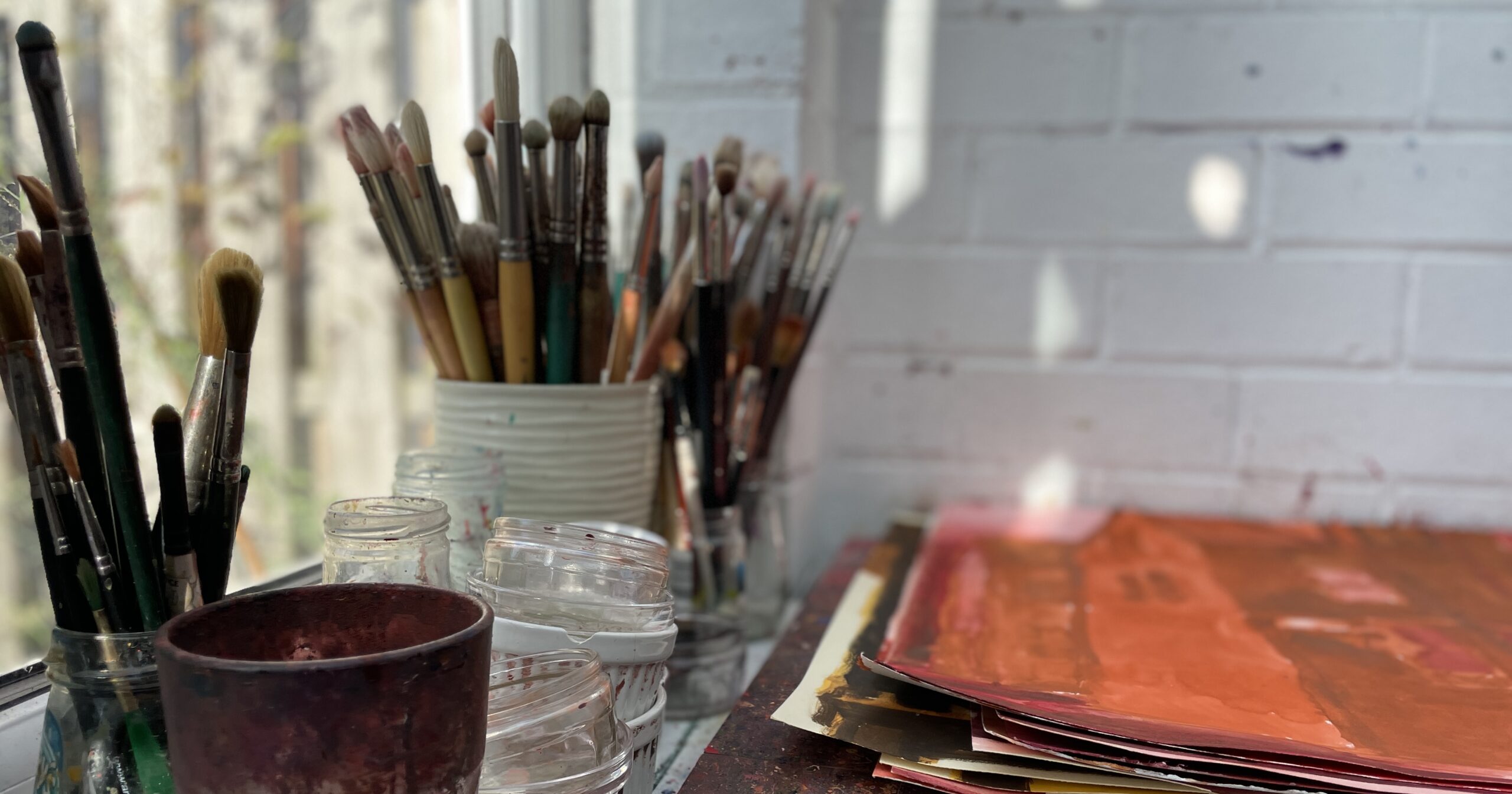
Brushes, jars and watercolour studies in the studio.
Court: What has been some of your career highlights thus far?
Jonathan: Being part of the Where We Live exhibition has been very exciting: it’s allowed me to show a large group of my paintings together, and to show alongside four wonderful painters who are also documenting particular places elsewhere in the country. I’ve learned a lot about painting and about the relationship between painting and place from the other painters and their work. The show was at the Millennium Gallery in Sheffield earlier this year, where we got a lot of visitors and some very positive feedback.
Court: Have you got a dream project you would love to make happen?
Jonathan: One thing I’d love to do is to make some much larger work. Most of my paintings are less than 1m wide, and if I had the studio space and the materials, I’d like to make something much bigger. I think with larger work two things happen: first, the scale of the work becomes closer to the scale of the subject, which makes the paintings something like a re-creation of it rather than an image. And second, I think colour becomes more powerful and altogether different in very large work, I’m thinking of what happens in abstract expressionist paintings.
Court: That would be brilliant to see how your work would translate to a larger scale. You’ve released several books. Can you tell us a bit more about those, how they came about and where they’re available?
Jonathan: Yes, I’ve got three books available with photographs of my paintings and drawings, covering the whole time I’ve been making paintings of Leeds, from 2010 to 2022. I made them because I thought it was a good way to show sequences and groups of paintings together, and to help me reflect on my work. It also provides a relatively affordable way for people to take my work home with them. The latest book, Local Colour, covers the period from April 2020 and includes a little writing on my process and on the places in the paintings. If you’re in the UK you can get the books direct from me, and for the rest of the world you can buy them from the Blurb platform. [Linked here]
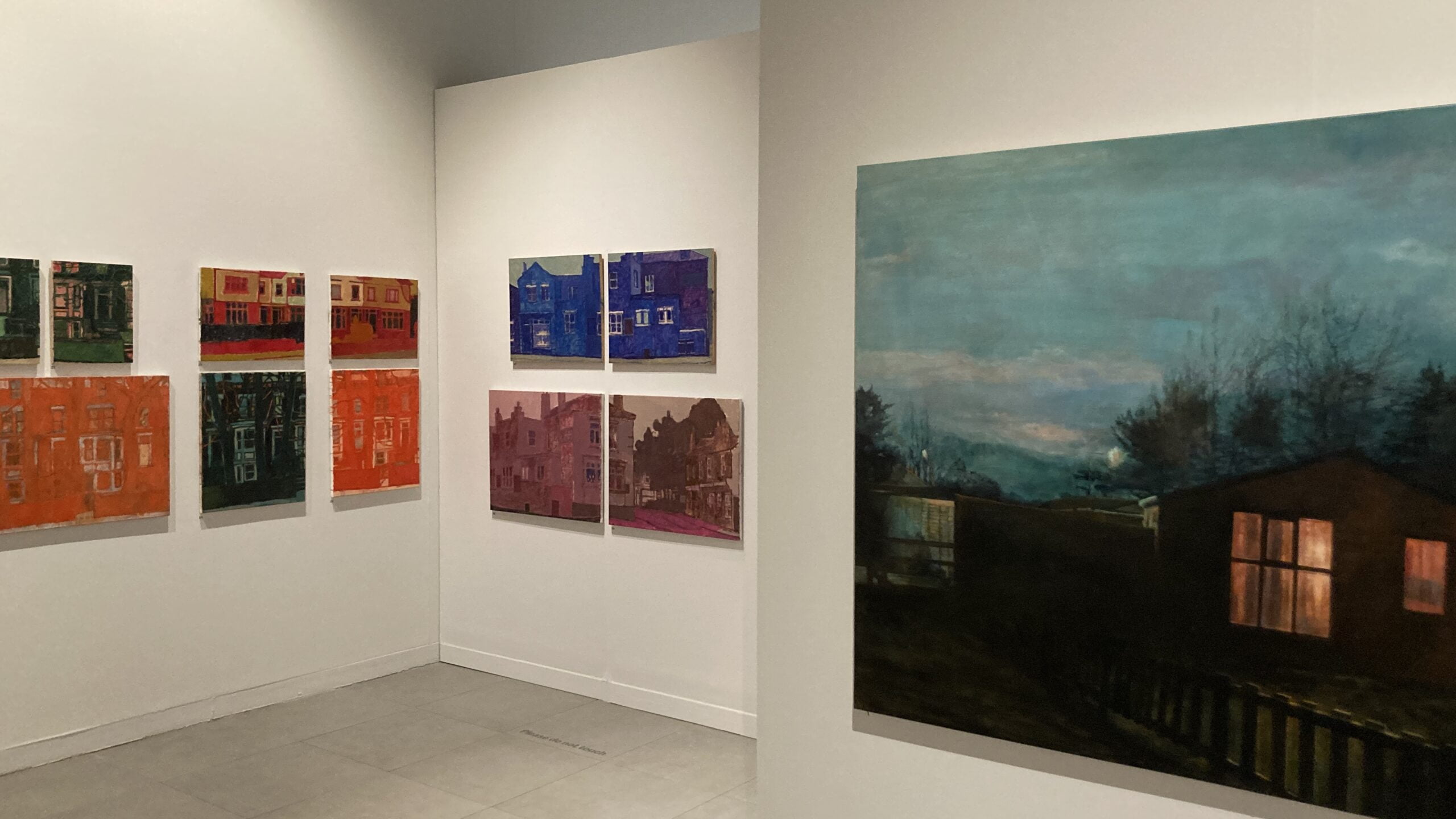
Works by Jonathan Hooper and Judith Tucker in Where We Live, in Sheffield.
Court: You’re currently in several exhibitions. Can you please tell us about those and the best way for people to keep up to date with your work?
Jonathan: I’m really pleased to have three paintings in The Mercer Open in Harrogate, which is on until January next year, where my work is alongside a lot of other Yorkshire artists I really admire. Our group exhibition Where We Live is moving to Lakeside Arts in Nottingham in February and I have two paintings in the Cupola Gallery, Sheffield at the moment. Finally, there are a couple of exciting things in the pipeline in Leeds, later this year and early next.
I’m on Instagram and Twitter where I post news of exhibitions, and a mixture of work-in-progress and finished work. I also send out an email newsletter about six times a year. If people contact me through social media or email (on my website) they can join my mailing list.
Court: That’s brilliant! Thank you so much for your time. I really am a big fan of your work and it was brilliant to snoop through your studio to find out more about your practice and approach.
Filed under: Art & Photography
Tagged with: building, colourpalette, creative, HOME, leeds, limited, oil, oil painting, painter, painting, personal, photography, residential, Studio

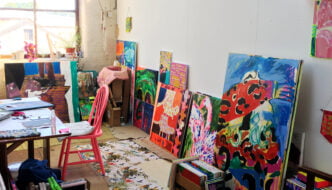

Comments